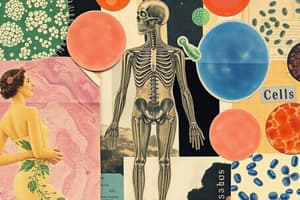Podcast
Questions and Answers
What type of system is operating when the response reverses the stimulus?
What type of system is operating when the response reverses the stimulus?
- Equilibrium feedback system
- Positive feedback system
- Negative feedback system (correct)
- Stimulus feedback system
How does a system operate by positive feedback?
How does a system operate by positive feedback?
- By enhancing or intensifying the stimulus (correct)
- By reversing the stimulus
- By maintaining equilibrium
- By remaining within certain narrow limits
What happens if a component of the body loses its ability to contribute to homeostasis?
What happens if a component of the body loses its ability to contribute to homeostasis?
- Homeostasis is maintained efficiently
- The body becomes resistant to diseases
- Normal balance among all processes is disturbed (correct)
- The body stays healthy
What is the result of a severe homeostatic imbalance?
What is the result of a severe homeostatic imbalance?
Which term refers to subjective changes in body functions that are not apparent to an observer?
Which term refers to subjective changes in body functions that are not apparent to an observer?
What is the main characteristic of organs in the human body?
What is the main characteristic of organs in the human body?
At which level of structural organization do vital organs fall?
At which level of structural organization do vital organs fall?
What is homeostasis primarily focused on?
What is homeostasis primarily focused on?
Which of the following is an example of an external disruption to homeostasis?
Which of the following is an example of an external disruption to homeostasis?
How does the human body respond to disturbances in homeostasis?
How does the human body respond to disturbances in homeostasis?
What is the role of an effector in a feedback system?
What is the role of an effector in a feedback system?
Which component of a feedback system evaluates the input received from receptors?
Which component of a feedback system evaluates the input received from receptors?
In a feedback system, what role does a receptor play?
In a feedback system, what role does a receptor play?
What characterizes a negative feedback system in a feedback loop?
What characterizes a negative feedback system in a feedback loop?
How does a positive feedback system differ from a negative feedback system in a feedback loop?
How does a positive feedback system differ from a negative feedback system in a feedback loop?
Which of the following is an example of a physiological sign of disease?
Which of the following is an example of a physiological sign of disease?
What organ system plays a crucial role in the maintenance of homeostasis?
What organ system plays a crucial role in the maintenance of homeostasis?
Which condition is a major homeostatic imbalance affecting blood sugar levels?
Which condition is a major homeostatic imbalance affecting blood sugar levels?
How do anatomical signs of disease differ from physiological signs?
How do anatomical signs of disease differ from physiological signs?
In the context of disease, what role do feedback systems play in maintaining homeostasis?
In the context of disease, what role do feedback systems play in maintaining homeostasis?
What is the main purpose of homeostasis in biological systems?
What is the main purpose of homeostasis in biological systems?
Which of the following best describes the characteristic of homeostasis?
Which of the following best describes the characteristic of homeostasis?
What type of disruptions can affect homeostasis in the human body?
What type of disruptions can affect homeostasis in the human body?
Which level of structural organization do organs belong to?
Which level of structural organization do organs belong to?
How is an organ system defined in terms of structure and function?
How is an organ system defined in terms of structure and function?
What type of feedback system reverses a change in a controlled condition?
What type of feedback system reverses a change in a controlled condition?
Which body structure monitors changes in a controlled condition and sends input to a control center in a feedback system?
Which body structure monitors changes in a controlled condition and sends input to a control center in a feedback system?
What does a positive feedback system tend to do to a change in one of the body’s controlled conditions?
What does a positive feedback system tend to do to a change in one of the body’s controlled conditions?
Which component of a feedback system produces a response that changes the controlled condition?
Which component of a feedback system produces a response that changes the controlled condition?
Organs are composed of only one type of tissue.
Organs are composed of only one type of tissue.
Homeostasis is a self-regulating process by which biological systems maintain stability.
Homeostasis is a self-regulating process by which biological systems maintain stability.
A vital organ not functioning can never result in death.
A vital organ not functioning can never result in death.
Cells are composed of water, inorganic ions, and carbon-containing molecules at the tissue level.
Cells are composed of water, inorganic ions, and carbon-containing molecules at the tissue level.
The chemical level of structural organization consists of subatomic particles like protons, electrons, and neutrons.
The chemical level of structural organization consists of subatomic particles like protons, electrons, and neutrons.
Homeostasis refers to a state of internal balance maintained by the body, while homeostatic imbalance indicates a disruption in this balance.
Homeostasis refers to a state of internal balance maintained by the body, while homeostatic imbalance indicates a disruption in this balance.
In a positive feedback system, the response reverses the stimulus.
In a positive feedback system, the response reverses the stimulus.
Homeostasis is maintained when body cells function inefficiently.
Homeostasis is maintained when body cells function inefficiently.
Moderate homeostatic imbalance can lead to death.
Moderate homeostatic imbalance can lead to death.
Disease is a less specific term compared to disorder.
Disease is a less specific term compared to disorder.
Vital organs are structures composed of only one type of tissue.
Vital organs are structures composed of only one type of tissue.
Homeostasis in the human body is a static condition that never changes.
Homeostasis in the human body is a static condition that never changes.
Moderate homeostatic imbalance always leads to death.
Moderate homeostatic imbalance always leads to death.
The chemical level of structural organization consists of four sub-levels.
The chemical level of structural organization consists of four sub-levels.
Homeostatic imbalances can only occur at the tissue level of structural organization.
Homeostatic imbalances can only occur at the tissue level of structural organization.
In homeostasis, cells are primarily composed of inorganic ions like sodium and potassium.
In homeostasis, cells are primarily composed of inorganic ions like sodium and potassium.
In a negative feedback system, the response enhances or intensifies the stimulus.
In a negative feedback system, the response enhances or intensifies the stimulus.
Homeostatic imbalance always leads to the occurrence of a disease.
Homeostatic imbalance always leads to the occurrence of a disease.
Cells are the smallest level of structural organization in the human body.
Cells are the smallest level of structural organization in the human body.
A fluctuation in maintaining equilibrium within the body is a characteristic of homeostasis.
A fluctuation in maintaining equilibrium within the body is a characteristic of homeostasis.
Flashcards are hidden until you start studying



